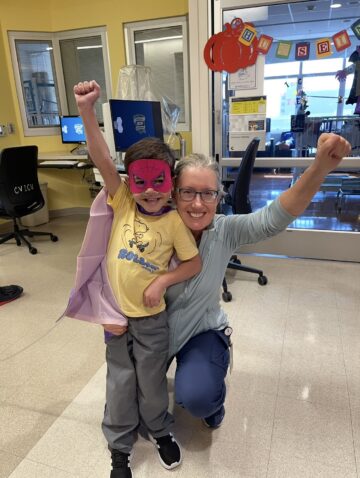Fainting, also known as syncope, is a brief loss of consciousness caused by a temporary lack of blood pressure to the brain that lasts just a minute or two, usually followed by a quick complete recovery. For most healthy kids, fainting is not a cause for alarm, but in rare cases, it may be a sign of an underlying heart condition.
If your child suddenly faints, it’s understandable to be worried. Dr. Gina Morchi, division chief of cardiology at the CHOC Heart Institute, explains common causes of fainting and when parents should seek treatment for their child.
Fainting causes for children and teens
For children and teens, fainting usually has no serious cause, though falls related to fainting can lead to injury. Common triggers for fainting may include:
- Dehydration. If children are not drinking enough water, especially in hot weather or after physical activity, it can lead to decreased blood volume and lower blood pressure. This is the most common cause of fainting for children and teens.
- Fear or strong emotional response to pain, injury or something shocking. When a child has an extreme emotional response to something, the part of their brain that controls blood pressure, heart rate and breathing may slow down as a protective mechanism and cause fainting.
- Hyperventilating or breathing too fast. When scared, upset or anxious, breathing too fast can cause rapid changes in blood supply to the brain.
- Standing for a long time or suddenly standing up. Standing for a long time can cause blood to pool in the legs because of gravity, and suddenly standing up causes low blood pressure.
- Breath-holding spells. Young children will commonly hold their breath during temper tantrums or in pain. This is generally not serious, and kids will typically grow out of it by age 6 years.
- Coughing very hard and other certain movements. There are instances in which laughing too hard, swallowing, weightlifting, going to the bathroom, or even hair-grooming may stretch or press on sensitive nerve endings. This trigger is rare, usually affecting teens, and the vast majority outgrow it.
Fainting signs and symptoms
Fainting often leads to falling down or needing to lie down due to a sudden drop in blood pressure or heart rate that causes decreased blood flow to the brain.
Before fainting, your child may show the following signs:
- Sweating
- Paleness
- Fast or irregular heartbeat
- Dizziness
- Lightheadedness
- Problems seeing
- Nausea or vomiting
What to do before and after your child faints
If you see some of the signs and symptoms that your child is about to faint, encourage them to do the following:
- Make sure they are in a safe place and have them sit down right away so they don’t fall and injure themselves.
- After they have safely sat down, have them lie down. Prop their feet up on some pillows or a jacket so that their feet are above the level of their heart. This will help raise blood flow to the heart and then the brain — which is exactly what they need.
- If they can’t lie down, place your child’s head between their knees to increase circulation to their brain.
- Turn them onto their side to prevent choking if they feel nauseous.
If your child has already fainted, lay them down with their feet slightly elevated like above. Loosen any tight clothing, make sure that they are cool and well ventilated, and don’t let them get up until they are feeling much better. Do not move them if you suspect that they were injured from falling.
When should I seek treatment for my child fainting?
You should seek immediate medical attention if your child fell and severely injured themselves from fainting; is having trouble speaking, seeing or moving; has chest pain or an irregular heartbeat; is having a seizure; or was physically active when it happened.
Anytime your child faints, you should visit your pediatrician for a checkup. In most cases, fainting due to the causes mentioned above will not indicate an underlying illness.
If your child is fainting on multiple occasions; fainting during exercise; having erratic and irregular heart rhythms; or if your family has a history of sudden cardiac death; you may need to be referred to a pediatric cardiologist by your primary pediatrician.
Common tests for fainting diagnosis
To find out if the cause of your child’s fainting is serious, your healthcare provider will ask you questions about how often you faint, how long they last and the events surrounding the episodes. Depending on the circumstances surrounding these episodes, your provider may order the following tests:
- Electrocardiogram (ECG). This gives information about heart rhythm and heart rate.
- Echocardiogram (echo). This shows the structure of the heart, including the valves.
- Orthostatic vital signs. This is where heart rate and blood pressure are measured while the patient is lying, sitting and standing. This is to see whether there is a change related to body position.
- Treadmill stress test. This helps a doctor determine how well your heart handlers work. As your body works hard during the exercise test, it requires more oxygen so the heart will pump more blood. During this test, doctors will monitor your blood supply to see if they may be reduced in the arteries.
- Ambulatory heart monitor or implantable loop recorder (ILR). If a healthcare provider thinks that the cause of the syncope may be related to patient’s heart rhythm, they may have the patient wear a heart monitor or recommend implanting a loop recorder underneath their skin to monitor their heart rhythm long term.
Other tests that may be done but are less common are stress testing, CT scan and MRI.
How to prevent fainting in the future
Your pediatrician or pediatric cardiologist may offer specified strategies to prevent your child from fainting in the future, but here are some general ideas:
- Try to find out what triggers may make your child faint. If the symptoms of fainting begin to occur, encourage your child to sit or lie down like mentioned above.
- Make sure your child is well hydrated and eating well. Make sure your child is not becoming dehydrated or skipping meals.
- Avoid overcrowded and stuffy environments.
- Have your child get up slowly if they have been sitting or lying down for a long period of time.
- Encourage your child to take breaks and flex their muscles if standing or standing for long periods to time to help keep their blood moving.
- Have your child take slow, deep breaths if they are anxious and breathing rapidly.
- Encourage regular physical activity to maintain good muscle and neurologic tone.
Get more expert health advice delivered to your inbox monthly by subscribing to the KidsHealth newsletter here.

Learn more about CHOC’s Heart Institute
CHOC Hospital was named one of the nation’s best children’s hospitals by U.S. News & World Report in its 2024-25 Best Children’s Hospitals rankings and ranked in the cardiology and heart surgery specialties.





